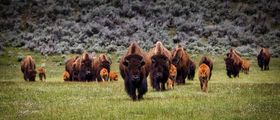


A holistic perspective is essential in agriculture.Because: In order to effectively manage land resources, increase biodiversity, increase production and achieve higher profits, aspects in one area cannot be changed or controlled without affecting another area.The prerequisite for effective management is therefore the use of symbiotic relationships in nature.
Allan Savory, the founder of holistic pasture management, explains: “The world is not only more complex than we think, it is also more complex than we can ever understand.For centuries man has tried to cultivate land with little success because land itself cannot be managed.The country is so closely linked to the culture of the people and the economy that all three areas have to be managed holistically. "
At holistic planned grazing, drought is measured on a scale from 1 to 10, with 1 standing for not arid and 10 for very arid.
The division is based on the extent to which moisture is available for growing organisms, how well moisture is distributed over the year and how quickly dead vegetation rots. The total amount of precipitation plays a subordinate role. Rather, it is considered how evenly the precipitation is distributed over the entire year and how constant the air humidity is on the soil surface over the course of the year. The longer and more stable the periods of moisture, the less arid the landscape. For example, rainforest can be classified at 1 on the drought scale, while desert can be classified at 10.
More than 60% of the world's land is more or less arid. Depending on the degree of drought, landscapes and the soil react differently to the same influences due to the speed and effectiveness of vegetation degradation. In non-arid areas, the vegetation decomposes quickly and is biodegraded. Small organisms such as molds, beetles, insects and microbes, all of which can survive outdoors at almost constant humidity, are primarily involved in the decomposition. In arid environments, however, the decay of vegetation is slower and almost always requires large grazing animals to facilitate decomposition. The grazing animals support the breaking down of the dead vegetation by bringing the plant material into contact with the surface of the earth by trampling and releasing excrement. Without the presence of large herbivores, soil-forming biodegradation is minimal in arid areas.
In the third principle, the original movements of huge wild herd animals play a role: If a natural enemy, i.e. a predator, was in the vicinity of the grazing animals, they would join together in a herd to protect themselves and flee. In doing so, they trampled both the plants and the ground. The soil broke up and the seeds of the plants were distributed on it. Since herd animals shed excrement in panic, the floor was also covered with feces and urine. The predator-prey behavior thus led to new grasses being planted and fertilized at the same time. It maintained vast grasslands in arid regions for millions of years. However, the predator-prey relationship was destroyed by humans by displacing the predator from the landscape. In the absence of a natural enemy, the herd animals increasingly relaxed and spread out across the landscape. They no longer have the same impact on the soil and vegetation.
In arid landscapes, herd animals that move close together play a major role in maintaining pasture health. The holistic planned grazing therefore use the predator-prey ratio: The cattle are managed in such a way that the animals' original behavior is imitated. The result: healthy pastures.
If animals stand too long on a grazing land or return there too early, the areas are overgrazed.After the grazing, the plants use energy from their roots to produce new leaves and roots.When the plants have produced enough leaf mass for photosynthesis again, they can replenish their energy stores.However, if animals stay on a grazing land for too long and eat plants before they can replenish their energy stores, the stores are exhausted and the roots recede: the plant is overgrazed.The same applies if animals return to the grazing land too early and eat plants before they have recovered.Overgrazing cannot take place on an entire pasture at the same time, but happens plant by plant.It therefore has nothing to do with the number of animals that are on the grazing area, but depends on the period.
A plant is overgrazed when:
Find out more about the next component of holistic planned grazing: the ecosystem processes